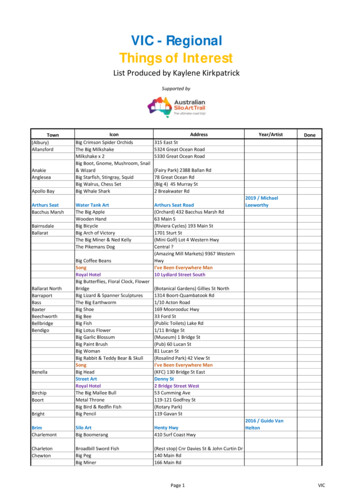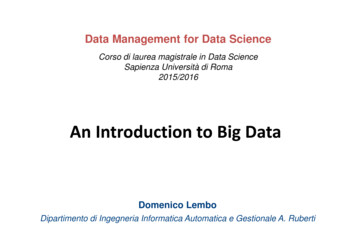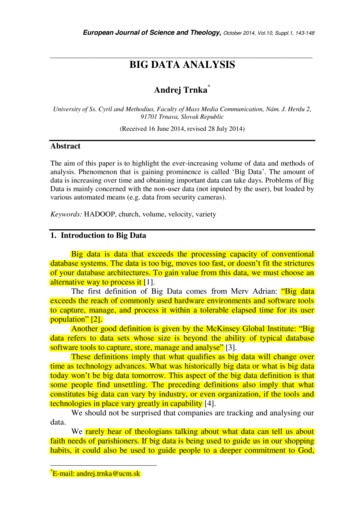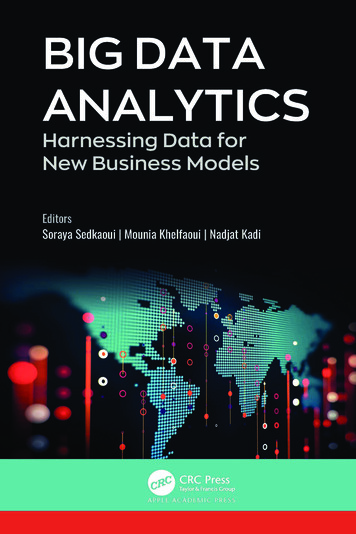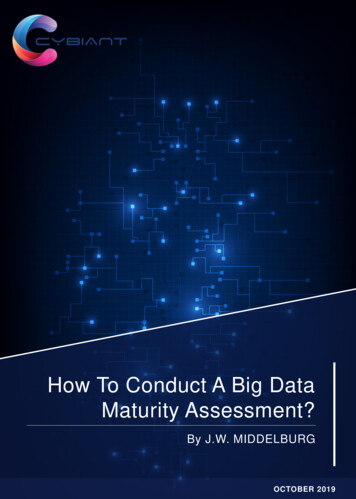
Transcription
How To Conduct A Big DataMaturity Assessment?1By J.W. MIDDELBURGwww.cybiant.com info@cybiant.com1OCTOBER 2019
W H I T EP A P E RHow to conduct a Big Data maturity assessment?How To Conduct A Big DataMaturity Assessment?Assess your organization’s methods and capabilities against best practices.1. INTRODUCTION TO MATURITY MODELSAs organizations feel pressure to gain competitive advantage, retaining their marketposition, identifying ways of cutting costs, improving quality, reducing time to market, theneed to invent or reinvent new products and services becomes increasingly important.Maturity models have been developed to assist organizations in this endeavour. In short,maturity models allow an organization to have its methods and processes assessedaccording to management best practice, often against a clear set of external benchmarks.In management theory, the term “maturity” is defined as the state of being complete,perfect or ready. 1 As such, it provides organizations with a long-term objective to strivefor, regardless of personnel changes, technology updates, or management hierarchies.Maturity provides a long term-goal, which can be achieved in a number of steps oriterations.Because of its iterative nature, organizations progress towards maturity in steps. Eachstep can be broken down into projects or activities, which makes progress towardsmaturity comprehensible. Most organizations start with an ‘initial’ state of maturity, whichmeans they have little capability in a specific domain. Over time, they progress towards‘total’ maturity, which means they are fully capable in the specific domain.The Big Data Maturity Model assists organization to progress from an initial state ofmaturity, with little or no capability in Big Data and Analytics, towards total maturity. Inthis last stage, the organization uses information from data sources (both internal and2external) for everyday decision making. Consequently, the Big Data Maturity Modelguides organizations towards data driven decision making.info@cybiant.com www.cybiant.com2
W H I T EP A P E RHow to conduct a Big Data maturity assessment?2. PURPOSE OF THE BIG DATA MATURITY ASSESSMENTBig Data Maturity can be defined as the evolution of an organization to integrate, manageand leverage all relevant internal and external data sources. 2 As a result, a Big estechnologies,datamanagement, analytics, governance and organizational components. Organizations use aBig Data Maturity model for one of the following two reasons:1. To track overall progress toward data-driven decision making. The Big DataMaturity Model functions as a measurement scale to track progress.2. To identify relevant initiatives to advance capability. The Big Data MaturityModel provides information to identify and prioritize projects and activities.Both objectives help organizations to further their capabilities in Big Data. Whereas thefirst objective provides an independents snapshot of the current state of the organizations(Where are we now?), the second objective provides input to advance the maturitytowards a higher level (How do get there?). Both objectives reinforce each other.The Big Data Maturity Model helps to create structure around a Big Data program anddetermines where to start. It is a simple yet effective tool for organizations to determinegoals around the program and communicate their visions for data-driven decision makingacross the organization.Additionally, the Big Data Maturity Model provides a proven methodology to measure,monitor and direct the state of the Big Data program and the efforts needed to movetowards the next maturity level. The model measures and manages the speed ofadoption, reporting both the progress and obstacles that organizations face in theirjourney towards data-driven decision making.The goal of the Big Data Maturity Model is to provide a capability assessment tool thatfocuses on specific Big Data key areas in organizations, help guide3 developmentmilestones and to avoid known pitfalls. Because of its strong focus on capabilities (i.e.the ability to succeed), Cybiant has developed the Big Data Capability Model as definedin the Enterprise Big Data Framework.info@cybiant.com www.cybiant.com3
W H I T EP A P E RHow to conduct a Big Data maturity assessment?3. BIG DATA MATURITY MODEL3.1 DESIGN METHODOLOGYFor the development of the Big Data Maturity Model, established academic and scientificpractices were used. 3 The development of the Big Data Maturity model, scope definitionand assessment questionnaires were conducted following the model developmentapproach, as depicted in figure 1:ScopeDesignPopulateTestDeployMaintainFIGURE 1: BIG DATA MATURITY MODEL DEVELOPMENT APPROACHEach of the phases are iterative in nature, helping to make adjustments throughout thewhole process. Each phase is equally contributed to the final design of the Big DataMaturity Model as presented in this paper.3.2 SCOPE DEFINITIONThe defining purpose of the Big Data Maturity Model has been structured as acomparative model. A comparative model has been chosen because they are best forcapturing domain and industry specific issues. They fulfill the following three objectives:1.To explain the state the maturity;2.To indicate how to approach improvement, better business performance andvalue;3.To provide benchmarking possibilities across industries or regions.The scope definition for the development (and testing) of the Big Data Maturity model hasbeen determined as enterprise and government organizations that have access,governance and control over large quantities of structured and unstructured data. Thescope definition is important. This is because the Big Data Maturity Model works underthe assumption that the organization that is measured against the assessment criteria will4have processes for data management, data governance, as well as data security anddata privacy policies. Although smaller SME organizations might score low against thesecriteria (because of the absence of such documents or processes).info@cybiant.com www.cybiant.com4
W H I T EP A P E RHow to conduct a Big Data maturity assessment?However, they could still benefit from the assessment to learn which processes andpolicies will need to be established to move towards higher maturity levels when theorganization expands.3.3 DOMAIN CAPABILITIESFor the development of the Big Data Maturity Model, the six capabilities of the EnterpriseBig Data Framework have been chosen. The Enterprise Big Data Framework consists ofsix core capabilities that organizations need to take into consideration when setting uptheir Big Data organization. A high-level overview of the Big Data Framework is depictedin figure 2:FIGURE 2: THE SIX CAPABILITIES OF THE ENTERPRISE BIG DATA FRAMEWORKThe reason why these capabilities have been selected is because they provide a holisticoverview of all aspects that need to be considered to be successful in Big Data. Each ofthe capabilities has a distinct focus, ranging from technical capabilities (the Big DataArchitecture capability) to knowledge development and skills (the Big Data Functionscapability). A short summary of the six measure capabilities is outlined below:1.Big Data Strategy - In order to achieve tangible results from investments in Big Data,enterprise organisations need a sound Big Data strategy. How can return on investments berealised, and where to focus efforts in Big Data analysis and analytics? The possibilities toanalyse are literally endless and organisations can easily get lost in the zettabytes of data. Asound and structured Big Data strategy is the first step to Big Data success.info@cybiant.com www.cybiant.com55
W H I T EP A P E RHow to conduct a Big Data maturity assessment?2.Big Data Architecture - In order to work with massive data sets, organisations should havethe capabilities to store and process large quantities of data. In order to achieve this, theenterprise should have the underlying IT infrastructure to facilitate Big Data. Enterprisesshould therefore have a comprehensive Big Data architecture to facilitate Big Data analysis.The Big Data Architecture element of the Big Data Framework considers the technicalcapabilities of Big Data environments. It discusses the various roles that are present within aBig Data Architecture and looks at the best practices for design.3.Big Data Algorithms - A fundamental capability of working with data is to have a thoroughunderstanding of statistics and algorithms. Big Data professionals therefore need to have asolid background in statistics and algorithms to deduct insights from data. Algorithms areunambiguous specifications of how to solve a class of problems. The Big Data algorithmselement of the framework focuses on the (technical) capabilities of organizations to retrievevalue from Big Data.4.Big Data Processes – Process capability helps enterprises to focus their direction.Processes bring structure, measurable steps and can be effectively managed on a day-to-daybasis. Additionally, processes embed Big Data expertise within the organization by followingsimilar procedures and steps, embedding it as ‘a practice’ of the organization.5.Big Data Functions - Big Data functions are concerned with the organisational capabilities ofmanaging Big Data in enterprises. This element of the Big Data framework addresses howorganisations can structure themselves to set up Big Data roles and discusses roles andresponsibilities in Big Data organisations. Organisational culture, organisational structuresand job roles have a large impact on the success of Big Data initiatives.6.Artificial Intelligence - One of the major areas of interest in the world today, AI provides awhole world of potential. The AI capability addresses the relationship between Big Data andArtificial Intelligence and outline the key capabilities of AI. The Big Data Framework takes afunctional view of AI in the context of bringing business benefits to enterprise organisations.By using the holistic model of six capabilities of the Big Data Framework, the Big DataMaturity Model fulfils the scope definition, covering all aspects of the enterprise and6providing relevant opportunities for improvement.info@cybiant.com www.cybiant.com6
W H I T EP A P E RHow to conduct a Big Data maturity assessment?3.4 ASSESSMENT MODELIn order to measure the capabilities over the six capability domains, a 5-point CapabilityMaturity Model is utilized. Developed by the Carnegie Mellon Software EngineeringInstitute (SEI), it is the most well-known maturity model, being accepted as the de factostandard by the IT Industry. 4 Because of the strong roots of Big Data in the technologydomain, the 5-point CMM-scale is the most suitable measurement approach formeasuring Big Data capability. The CMM proposes a five-stage evolutionary path anddefines five different levels of process maturity, illustrated in figure 3:FIGURE 3: BIG DATA MATURITY MODEL DEVELOPMENT APPROACHThe whole CMM model ultimately consists of the four different aspects, which are used inthe Big Data Maturity Model: Maturity Levels are well-defined evolutionary entities toward achieving mature Big Datacapabilities, across the 6 domains of the Big Data Framework. Each maturity levelindicates a level of process capability. The CMM consists of five maturity levels,namely Initial, Repeatable, Defined, Managed and Optimizing Key Process Areas (KPAs) indicate the areas an organization should focus on to7improve its Big Data capabilities and to achieve process capability goals. There are anumber of KPAs located at each maturity level.info@cybiant.com www.cybiant.com7
W H I T EP A P E RHow to conduct a Big Data maturity assessment? ewhethertheimplementation and institutionalization of a KPA is effective, repeatable, and lasting.The five common features are commitment to perform, ability to perform, activitiesperformed, measurement and analysis, and verifying implementation. Key Practices describe the infrastructure and activities that contribute most to theeffective implementation and institutionalization of the key process area.Based on the domain capabilities (section 3.3) and the assessment model (section 3.4),the Big Data Maturity Assessment was developed. The Big Data Maturity Assessmentwas developed. The Big Data Assessment can be conducted by organizations (typicallyannually) to measure the Big Data maturity and identify improvement opportunities.3.5 ASSESSMENT EVALUATION AND VALIDATIONIn order to objectively measure capability across organizations (to be used as thebenchmark) a total of 180 questions have been developed. Theses consists of the 6domains, for which in each domain 30 questions have been developed.An example of the questions for the ‘data governance process’ (part of Big Dataprocesses) is illustrated in figure 4:8FIGURE 4: EXAMPLE QUESTIONS FOR THE DATA GOVERNANCE PROCESSinfo@cybiant.com www.cybiant.com8
W H I T EP A P E RHow to conduct a Big Data maturity assessment?The Big Data Maturity assessment in organizations can be either done through externalaudit or individual self-assessment. It is recommended that the latter should beapproached as a team exercise involving people from different functional groups, toultimately eliminate single-respondent bias. 54. RESULTS AND BENCHMARKING4.1 RESULT OF THE BIG DATA MATURITY ASSESSMENTDuring the Big Data Maturity Assessment, every area of the Big Data Framework issubsequently assessed to determine the level of capability. The outcome of the Big DataAssessment Model is depicted in figure 5 and provides valuable information on thepotential improvement areas for the organization.FIGURE 5: EXAMPLE QUESTIONS FOR THE DATA GOVERNANCE PROCESS4.2 BENCHMARKING OF ASSESSMENT RESULTSBecause of the objective nature of the Big Data Maturity Assessment and correspondingquestionnaires, the results provide input information for a global benchmark report.Because a comparative model was selected (see section 3.2), the maturity results can be9used by organizations to determine how they compare with regards to industry or regionalpeers. Benchmarking can compare an actual situation with industry-specific bestpractices in order to support management decisions for continual improvement.info@cybiant.com www.cybiant.com9
W H I T EP A P E RHow to conduct a Big Data maturity assessment?Industry specific benchmarks that are captured are: ManufacturingOil & GasUtilitiesBankingAerospace & DefenseHealthcareRetailTelecommunicationsSmart CitiesTransportationIn this case, the Big Data Maturity Model is essentially used as a representation of theas-is situation, recommendation for action, and an instrument for controlling. The modelalso raises awareness of the analysis aspect and serves as a frame of reference forimprovements, ensuring a certain quality and avoiding errors.5. ABOUT THE AUTHORJan-Willem Middelburg is the CEO and co-founder of Cybiant, based in Kuala Lumpur. Hestarted Cybiant with the mission to make a more sustainable world for the NextGeneration through the use of data and automation. Jan-Willem authored and coauthored numerous books, including Serious Gaming (2013), The Service AutomationFramework (2017) and recently The Enterprise Big Data Framework (2018).A pioneer and advocate for professionalisation in Automationand Big Data, he is a frequent keynote speaker and moderatorat universities and technology conferences around the world.Jan-Willem holds a Bachelor’s degree in Industrial Engineering,a Master’s in Supply Chain Management from the RotterdamSchool of Management, and is currently pursuing a secondMaster’s degree in Computer and Information Technology at theUniversity of Pennsylvania.1Dictionary, O.E., 1989. Simpson, JA, W einer, ESC.102Halper, F. and Krishnan, K., 2013. TDW I big data maturit y model guide interpreting your assessment score. TDW I Benchmark Guide, 2014,p.20133De Bruin, T., Freeze, R., Kaulkarni, U. and Rosemann, M., 2005. Understanding the main phases of developing a maturity assessment model4Mettler, T., 2009. A design science research perspective on maturity models in information systems.5Mettler, T., Rohner, P. and W inter, R., 2010. Towards a classification of maturity m odels in information systems. In Managem ent of theinterconnected world (pp. 333-340). Physica-Verlag HDinfo@cybiant.com www.cybiant.com10
The Big Data Maturity Model assists organization to progress from an initial state of maturity, with little or no capability in Big Data and Analytics, towards total maturity. . have processes for data management, data governance, as well as data security and data privacy policies. Although smaller SME organizations might score low against these


